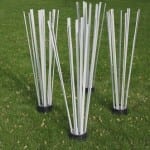NOAA announced today that it has awarded nearly $5 million to eight projects to support habitat restoration throughout the Great Lakes Areas of Concern. NOAA’s Restoration Center is funding three shovel-ready projects and five engineering and design projects. This allows NOAA to support both current efforts to restore the Great Lakes as well as future projects that, once implemented, will have significant benefits to Great Lakes restoration.
NOAA provides financial and technical assistance to remove dams and barriers, construct fish passage, clean up marine debris, restore coastal wetlands, and remove invasive species in the region.
Implementation projects include:
• Wayne Road Dam Removal and Habitat Improvement Project (Wayne, MI) – $1million: The Alliance of Rouge Communities will remove the Wayne Road Dam. This will restore fish passage to migratory species such as salmon, walleye, northern pike and small mouth bass, and improve shoreline habitat. It will also reconnect 22 miles of the Rouge River with the Great Lakes.
• Lower Black River Habitat Restoration (Lorain, OH) – $1million: In the second phase of this project, the City of Lorain, Ohio will build more than 2,800 feet of prime vegetated fish habitat for walleye, smallmouth bass, and northern pike. This project will also restore up to two acres of riparian habitat, and will remove more than 45,000 cubic yards of recyclable steel mill slag in the Black River watershed – a tributary to Lake Erie.
• Habitat Restoration in the Maumee Area of Concern (Oak Harbor, OH) – $1.3 million: The Nature Conservancy, in partnership with Ducks Unlimited and U.S. Fish and Wildlife Service, will restore and enhance 512 acres of critical coastal wetland and marsh habitat within Ottawa National Wildlife Refuge. The project will reconnect 127 acres of wetlands to Lake Erie.
Engineering and design projects and future implementation impacts include:
• Muskegon Lake Hydrologic Reconnection and Mill Debris Removal (Muskegon, MI) – $313,000: The West Michigan Shoreline Regional Development Commission will develop designs for a project that will soften 2,850 feet of shoreline, restore up to 126 acres of floodplainsand emergent wetlands, and remove more than 197,000 metric tons of unnatural lake fill debris.
• Little Rapids Habitat Restoration Project (Sault St. Marie, MI) – $348,000: The Eastern Upper Peninsula Regional Planning & Development Commission will begin developing engineering and design plans for a project that will increase fish passage in the remaining available rapids habitat, considered essential spawning and nursery habitat for species such as lake whitefish, lake sturgeon and walleye.
• Clinton River Spillway and Fish Habitat Restoration (Clinton Township, MI) – $350,000: Macomb County will develop plans to improve fish passage along two miles of restored channel, directly connecting nearly 200 acres of river corridor to Lake St. Clair. The project will refurbish and adapt the existing spillway to reduce erosion and sediment loading by stabilizing river shorelines and by increasing vegetated buffers along the river.
• Buffalo River RiverBend Habitat Restoration project (Buffalo, NY) – $167,000: Buffalo Niagara Riverkeeper will develop plans to restore and soften 1,520 feet river shoreline. The shoreline is currently channelized and made of hard materials like steel which can contribute to erosion and degrade and alter habitat. Additionally, almost four acres of shoreline and riparian habitat will be stabilized and planted, creating a 100-foot vegetated buffer area along the river.
• Lower Black River Fish Habitat Restoration Project (Lorain, OH) – $350,000: In the third phase of this project, the City of Lorain, Ohio will develop plans to build shallow underwater rocky fish habitat shelves, totaling more than 1,600 feet of new prime vegetated fish habitat for walleye, smallmouth bass, northern pike and longnose gar. This project, once implemented, will also restore up to seven acres of riparian habitat from a former industrial area back to its original natural forested state in the Black River watershed—a tributary to Lake Erie.
See the dozens of unique artificial fish habitat models, fish attractors and fish cover used at fishiding.com, the industry leader and only science based, man made and artificial fish habitat, proven to provide all fish with cover they prefer to prosper.
These projects are supported by the NOAA Restoration Center with funding provided by the U.S. EPA via President Obama’s Great Lakes Restoration Initiative. The Great Lakes Restoration Initiative is a collaborative effort between the EPA and 15 other federal agencies to build on existing and current work to restore the Great Lakes.
For more information on the Initiative and Action Plan go to www.greatlakesrestoration.us.
NOAA’s mission is to understand and predict changes in the Earth’s environment, from the depths of the ocean to the surface of the sun, and to conserve and manage our coastal and marine resources. Join us on Facebook , Twitter and our other social media channels.
SOURCE: NOAA

